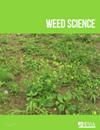New Directions in Weed Management and Research Using 3D Imaging
IF 2.1
2区 农林科学
Q2 AGRONOMY
引用次数: 2
Abstract
Abstract Recent innovations in 3D imaging technology have created unprecedented potential for better understanding weed responses to management tactics. Although traditional 2D imaging methods for mapping weed populations can be limited in the field by factors such as shadows and tissue overlap, 3D imaging mitigates these challenges by using depth data to create accurate plant models. Three-dimensional imaging can be used to generate spatiotemporal maps of weed populations in the field and target weeds for site-specific weed management, including automated precision weed control. This technology will also help growers monitor cover crop performance for weed suppression and detect late-season weed escapes for timely control, thereby reducing seedbank persistence and slowing the evolution of herbicide resistance. In addition to its many applications in weed management, 3D imaging offers weed researchers new tools for understanding spatial and temporal heterogeneity in weed responses to integrated weed management tactics, including weed–crop competition and weed community dynamics. This technology will provide simple and low-cost tools for growers and researchers alike to better understand weed responses in diverse agronomic contexts, which will aid in reducing herbicide use, mitigating herbicide-resistance evolution, and improving environmental health.杂草管理和3D成像研究的新方向
摘要3D成像技术的最新创新为更好地了解杂草对管理策略的反应创造了前所未有的潜力。尽管绘制杂草种群地图的传统2D成像方法在野外可能会受到阴影和组织重叠等因素的限制,但3D成像通过使用深度数据创建准确的植物模型来缓解这些挑战。三维成像可用于生成田间杂草种群和目标杂草的时空图,用于特定地点的杂草管理,包括自动化精确杂草控制。这项技术还将帮助种植者监测覆盖作物的除草性能,并检测晚季杂草的逃逸情况,以便及时控制,从而减少种子库的持久性,减缓除草剂耐药性的演变。除了在杂草管理中的许多应用外,3D成像还为杂草研究人员提供了新的工具,以了解杂草对综合杂草管理策略反应的空间和时间异质性,包括杂草-作物竞争和杂草群落动态。这项技术将为种植者和研究人员提供简单而低成本的工具,以更好地了解杂草在不同农艺环境中的反应,这将有助于减少除草剂的使用,减缓除草剂耐药性的演变,并改善环境健康。
本文章由计算机程序翻译,如有差异,请以英文原文为准。
求助全文
约1分钟内获得全文
求助全文
来源期刊

Weed Science
农林科学-农艺学
CiteScore
4.60
自引率
12.00%
发文量
64
审稿时长
12-24 weeks
期刊介绍:
Weed Science publishes original research and scholarship in the form of peer-reviewed articles focused on fundamental research directly related to all aspects of weed science in agricultural systems. Topics for Weed Science include:
- the biology and ecology of weeds in agricultural, forestry, aquatic, turf, recreational, rights-of-way and other settings, genetics of weeds
- herbicide resistance, chemistry, biochemistry, physiology and molecular action of herbicides and plant growth regulators used to manage undesirable vegetation
- ecology of cropping and other agricultural systems as they relate to weed management
- biological and ecological aspects of weed control tools including biological agents, and herbicide resistant crops
- effect of weed management on soil, air and water.
 求助内容:
求助内容: 应助结果提醒方式:
应助结果提醒方式:


